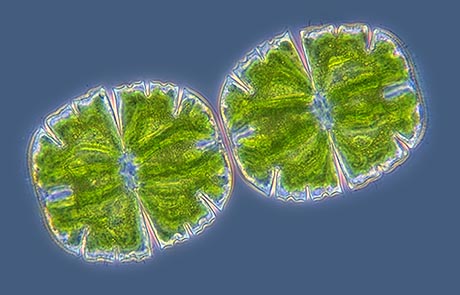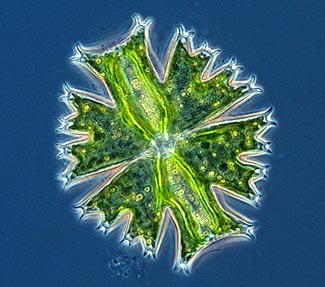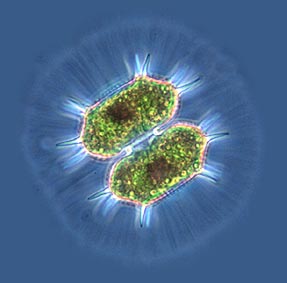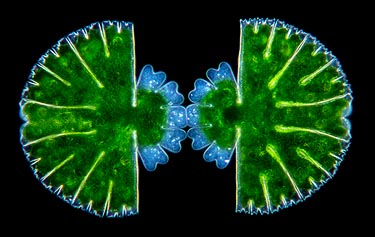
Two Micrasterias truncata still attached after cell division
| | by Wim van Egmond |
 Two Micrasterias truncata still attached after cell division | |
 Micrasterias crux melitensis, with delicate spined arms | What
are desmids? Desmids (or Desmidiaceae) are single-celled green algae which can only be found in fresh water. Desmids have spectacular symmetrical shapes. Because they are so small, their beauty is hidden for most of us. Only with the aid of a microscope can their splendor be revealed. Desmids can be recognised by their symmetry. Two, mostly ornamented semi-cells are joined by a narrow connection called the isthmus. This where the spherical nucleus is situated. Each semi-cell houses a large, often folded chloroplast. One or more pyrenoids can be found. These form carbohydrates for energy storage. |
Desmids show a wide variety of body shapes and many species are ornamented with all kinds of knobs and spines. There are circular, rotund, elongated, star-shaped and even moon-shaped species, like this Closterium. There are also desmids that form long filaments. |
|
 | Many Desmids secrete mucilage from pores in the cell wall. With this they can move towards light or avoid too bright light. It also acts as a protective layer.
Xantidium, smaller than one tenth of a millimetre | |
 |
| Where
can you find Desmids? Desmids need water of specific quality, most species require water with a certain acidity and without too many nutrients. Between sphagnum moss in bogs and marshes you may find many species. An easy way to collect them is to squeeze the water out of sphagnum into a jar. It may take some time to find a good source but the advantage of these acid waters is that it will stay fresh for a long time. Kept in a shallow container with a lid you can keep these 'micro-jewels' for months. |
Desmids reproduce by fission, the cells divide. It is an interesting to see this whole process in desmids. This image of Micrasterias thomasiana shows how it works. The nucleus divides and near the isthmus two new semi-cells are formed. For several hours the semi-cells keep growing until they are big enough to separate into two individuals. Often we see desmids with one semi-cell less developed than the other. |  |
Desmids are related to the algae that form pond scum (filamentous algae like Spirogyra) and like them they conjugate. After two individuals exchange genetic information they form a so-called zygospore that is able to withstand harsh conditions. |
| There are also several genera of desmids that form filaments. An interesting species is Desmidium swartzii. They form long chains. The cells are all slightly twisted to one another and this results in a helix. |
Staurastrum, just after cell division. These tiny Desmids often have very interesting three-dimensional shapes. Because they are so small it is not easy to capture that in a photograph. In a drawing it is easier to show its 3D design. Apart from the external structure I tried to show their internal anatomy. The nucleus is visible as a light sphere between the pyrenoids, they use to store energy. This desmid can also be seen being captured by an Amoeba. |
|
| |
|
|
|
|
| Read the following MICSCAPE articles to find out more about a variety of desmids and relatives |
| Stars
of the marshes Observations on the Desmidiaceae A rare form of a beautiful desmid Notes on the movements of desmids Optical and SEM examination of some species of the desmid genus Euastrum Desmids and other algae: primary producers in the food chain |
use the POND
LIFE IDENTIFICATION KIT!
Comments to the author Wim van Egmond are welcomed.
or visit Wim's HOME PAGE
Microscopy
UK Front Page
Micscape
Magazine
Article
Library
all material © Wim van Egmond